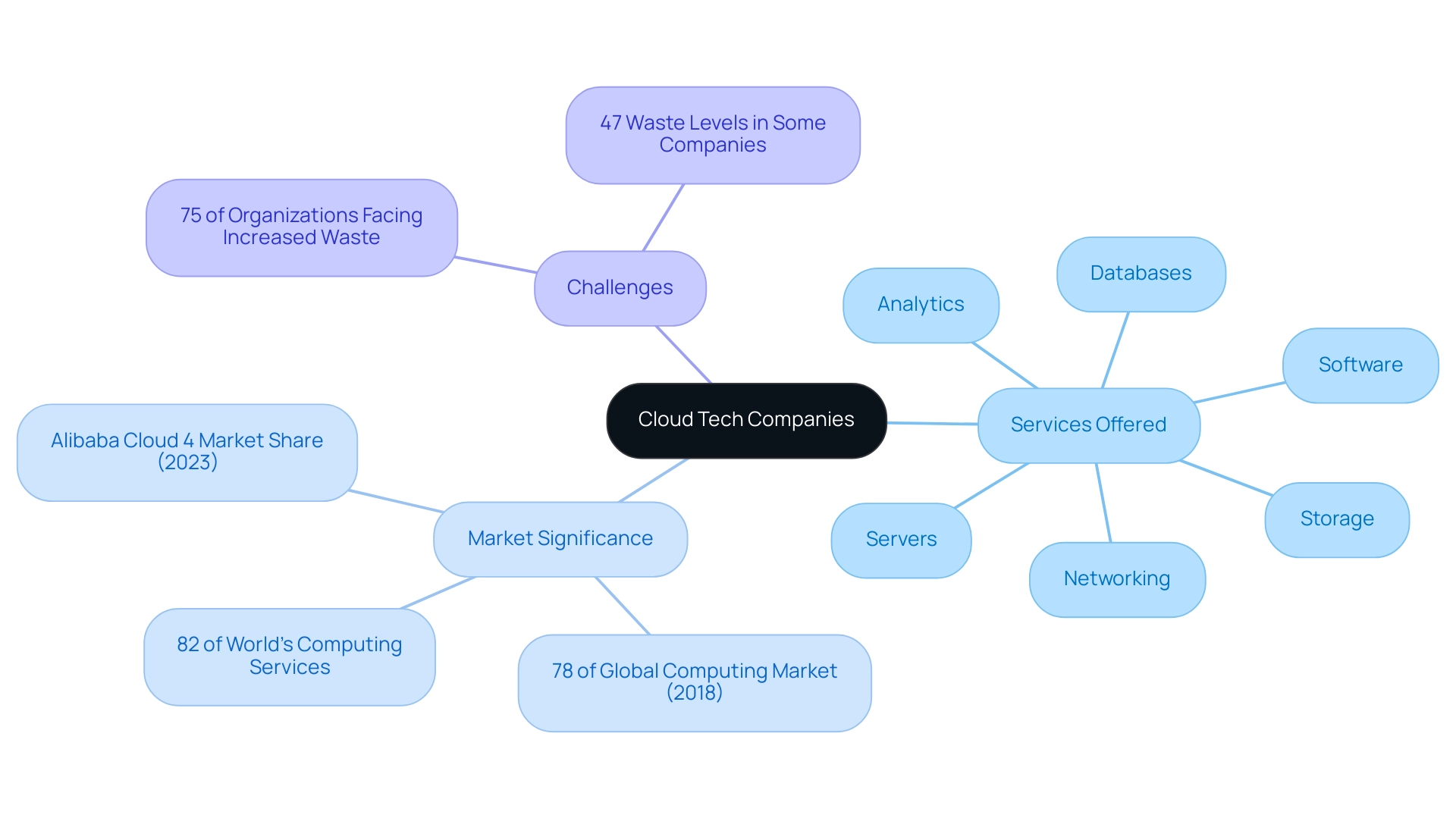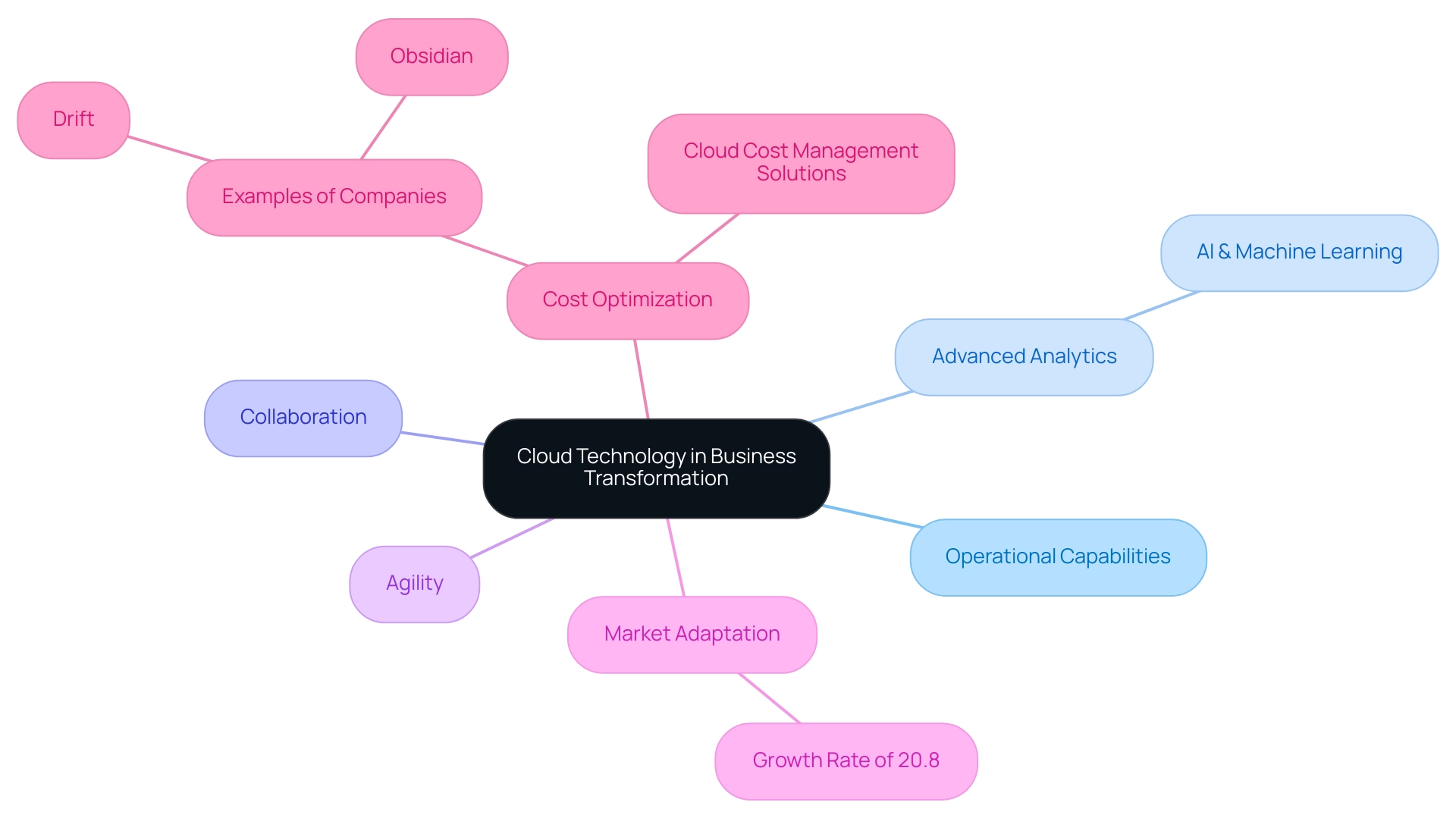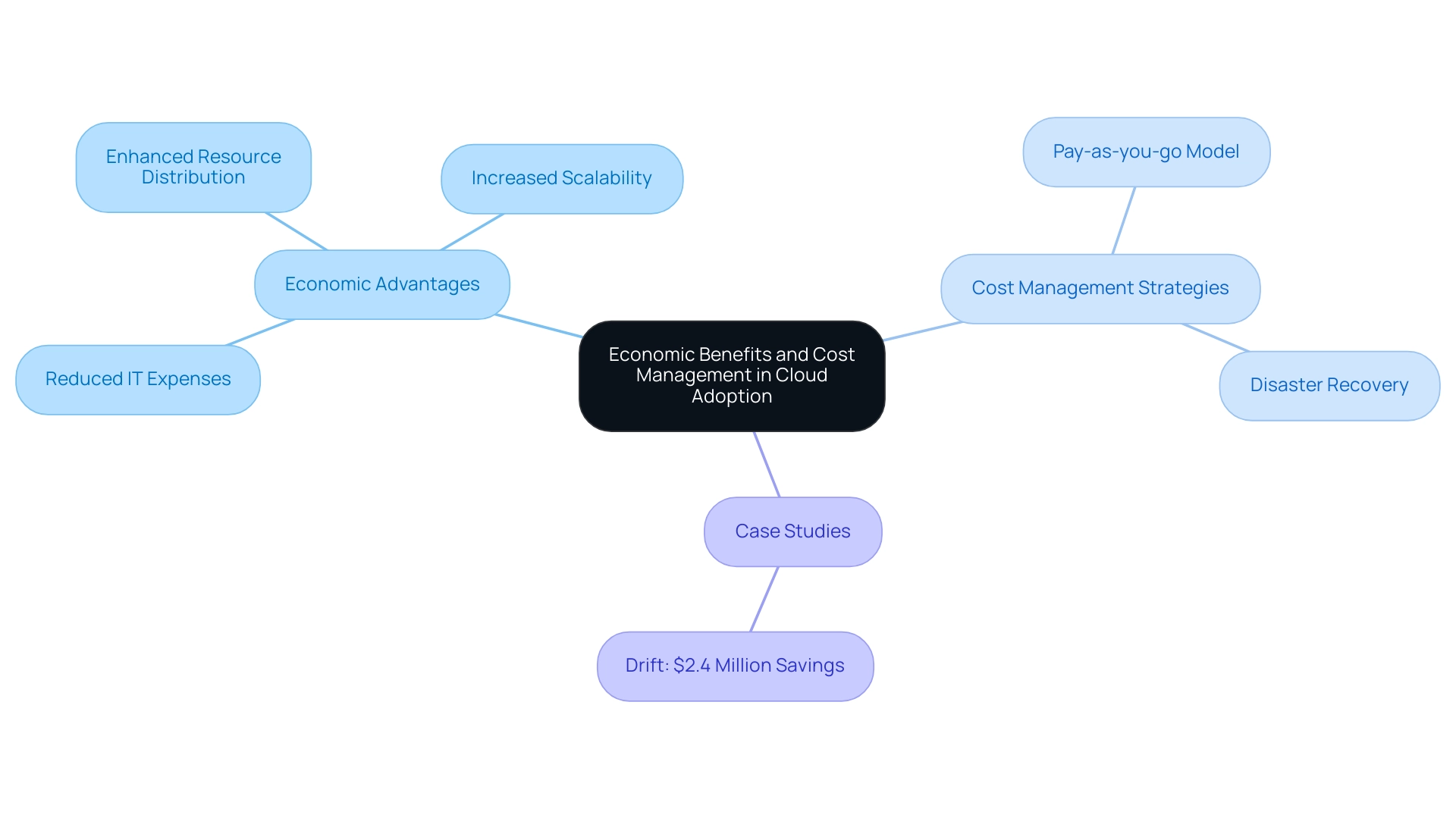Introduction
The landscape of cloud technology is rapidly reshaping the way businesses operate, offering unprecedented opportunities for innovation and efficiency. As organizations increasingly turn to cloud solutions, they find themselves not only enhancing operational capabilities but also navigating the complexities of security and cost management.
With industry leaders like Amazon Web Services, Microsoft Azure, and Google Cloud Platform at the forefront, the evolution of cloud services is not merely a trend but a fundamental shift in how companies approach their strategic goals. This article delves into the pivotal role of cloud technology, exploring its economic benefits, the challenges organizations face, and the future trajectory of this dynamic sector.
As businesses strive for agility and resilience in an ever-changing market, understanding the implications of cloud adoption becomes essential for sustainable growth and competitive advantage.
Defining Cloud Tech Companies: An Overview
Service providers in the contemporary digital environment are crucial participants, offering vital services through advanced computing solutions. These organizations leverage the internet to deliver a wide array of computing resources, including:
- Servers
- Storage
- Databases
- Networking
- Software
- Analytics
Industry giants such as Amazon Web Services (AWS), Microsoft Azure, and Google Platform exemplify the capabilities of cloud tech companies, which have rapidly evolved to meet the demands of businesses seeking agility and scalability.
The significance of cloud tech companies extends beyond mere service provision; they empower organizations to innovate swiftly and respond effectively to market changes. Significantly, approximately half of the surveyed companies acknowledge this technology as a contemporary data protection approach, emphasizing that the move towards it is not merely a trend but a crucial change in operational strategy. In 2018, the public infrastructure accounted for 78% of the global computing market, underscoring its dominance, particularly in Software as a Service (SaaS) offerings.
Cody Slingerland observed that
Combined, these two regions represent 82% of the world’s computing services,
indicating the concentrated growth in this sector.
However, the rapid expansion of computing services also presents challenges. Recent reports indicate that 75% of organizations are grappling with increased waste in their online storage, with some companies experiencing waste levels as high as 47% of their budgets. This essential area for enhancement highlights the necessity for companies to optimize their investments in online services.
As we approach 2024, the computing industry continues to exhibit significant growth, with Alibaba capturing a 4% market share, which illustrates the increasing competition and ongoing innovation within the space. The advantages of online computing—for operational efficiency, cost reduction, and enhanced agility—are clear, making it an indispensable element of modern business strategy.

The Role of Cloud Technology in Business Transformation
A cloud tech company serves as a cornerstone for business transformation through cloud technology, significantly enhancing operational capabilities, streamlining processes, and enriching customer experiences. As organizations transition to online services, they can harness advanced analytics, artificial intelligence, and machine learning, enabling them to extract valuable insights and drive innovation. This technological shift not only promotes collaboration by offering access to shared resources and tools from any location but also cultivates a culture of agility and responsiveness.
Businesses that embrace online solutions are better positioned to swiftly adapt to market fluctuations, accelerate the development of new products and services, and ultimately secure a competitive advantage. For instance, companies like Drift and Obsidian have successfully reduced their expenses associated with online storage through strategic management, illustrating effective approaches to optimizing such expenditures. Moreover, with global expenditure on innovations and services facilitating digital transformation anticipated to hit $2.3 trillion by 2023, the necessity for companies to adopt solutions from a cloud tech company is more essential than ever.
With the online market projected to grow at a compound annual growth rate of 20.8%, it is clear that adopting this technology is crucial for businesses aiming to thrive in a rapidly evolving landscape. As Cody Slingerland highlighted, the U.S. and Western Europe alone represent 82% of the global computing market, emphasizing the importance of these areas in influencing the future of innovations.

Ensuring Security in Cloud Environments
The protection of online systems is a vital issue for organizations seeking to safeguard their information from increasing cyber threats and breaches. In 2024, the environment of online protection is increasingly affected by the concerning statistic that 82% of organizations have faced third-party data breaches, which result in an average remediation expense of $7.5 million. Moreover, the average total cost of a mega breach, involving 50-60 million records, was $332 million, highlighting the severe financial implications of such incidents.
Prompted by these risks, leading cloud tech companies have enhanced their offerings, providing a comprehensive suite of protective measures, including:
- Advanced encryption
- Stringent access controls
- Regular audits designed to fortify infrastructures
Organizations must also take an active role in their protective stance by implementing robust protocols such as:
- Multi-factor authentication
- Continuous oversight of online resources
Significantly, 46% of business IT leaders recognize external entities, such as hackers, as the greatest threat to their data, highlighting the necessity for vigilance against these dangers. Rapid7 has established itself as a market participant, ranking third with a significant 10% share in online protection solutions.
As stated by Rapid7, "[insert quote here]", underscoring the competitive nature of this sector. Moreover, compliance with regulations like GDPR and HIPAA is not merely a legal obligation; it is a necessary component of a robust security strategy. Organizations must ensure that their cloud tech company providers meet these compliance standards to avoid significant liabilities.
The T-Mobile information compromise serves as a stark reminder of the potential scale and impact of breaches, with an estimated 37 million individuals affected. This incident illustrates the dire consequences that can arise from insufficient protective measures. Thus, a thorough online security plan is crucial—not just to safeguard sensitive information but also to foster customer confidence, which is becoming more important in today's digital environment.

Economic Benefits and Cost Management in Cloud Adoption
The implementation of online technology offers substantial economic advantages, including reduced IT expenses, enhanced resource distribution, and increased scalability. By transitioning to a pay-as-you-go model, organizations can circumvent the significant capital expenditures typically associated with traditional IT infrastructure. This approach not only enables businesses to pay only for the resources they utilize but also facilitates dynamic scalability based on demand.
As a result, companies can optimize their cost management strategies effectively. Recent studies suggest that half of surveyed companies have transitioned to remote storage mainly for disaster recovery, highlighting its essential role in contemporary information protection strategies. In fact, half of surveyed enterprises regard online computing as an essential component of their information protection strategy, emphasizing its significance.
Furthermore, the average expense of a data breach in the online environment is $3.86 million, emphasizing the financial implications of not adopting digital solutions. A cloud tech company provides solutions that are proven to boost productivity and efficiency, allowing employees to access essential tools and information remotely. This connectivity minimizes downtime and fosters better collaboration across teams.
Notably, IBM Cloud reported revenue of $25.1 billion in 2020, focusing on hybrid solutions for enterprise customers, which illustrates the growing market and demand for services. Organizations that have integrated cost management strategies, such as those highlighted in the 'Cloud Cost Management Success Stories,' have realized impressive savings; Drift alone achieved an annual reduction of $2.4 million in expenses. These examples demonstrate the potential for substantial cost savings and improved operational efficiency through strategic technology adoption.

The Future of Cloud Technology in Business Strategy
The path of digital solutions is poised for strong expansion and change, mainly fueled by the incorporation of artificial intelligence (AI), machine learning, and the Internet of Things (IoT). As organizations increasingly utilize these advanced systems, online platforms are anticipated to become essential to their operational frameworks. Significantly, the growth of edge computing will further improve online solutions by enabling real-time information processing at the source, thus enhancing responsiveness and efficiency.
According to Gartner:
- AWS commanded a dominant 38.9% market share in the Infrastructure as a Service (IaaS) sector during 2020/2021.
- Google Cloud Platform (GCP) witnessed a remarkable 63.7% growth in its IaaS offerings, reflecting the dynamic nature of this competitive landscape.
- Furthermore, 54% of sensitive data is encrypted among companies that store information online, emphasizing the critical importance of security in digital systems.
- The U.S. and Western Europe represent 82% of the global computing market, highlighting the geographical distribution of technology adoption.
Furthermore, in Q4 2023:
- AWS, Microsoft Azure, and Google Cloud collectively accounted for 66% of total cloud spending, amounting to $78.1 billion.
- Microsoft Azure outpaced the market with a 30% growth rate.
Companies that proactively embrace these innovations will be well-positioned to secure a competitive edge, potentially transforming into a leading cloud tech company in their respective sectors. As technological advancements continue to unfold, the ability to adapt and innovate will be crucial for long-term success in the evolving digital landscape.

Conclusion
The exploration of cloud technology reveals its transformative power in the contemporary business environment. As organizations increasingly migrate to cloud platforms, they unlock a wealth of resources that enhance operational capabilities, drive innovation, and foster agility. Industry leaders such as:
- Amazon Web Services
- Microsoft Azure
- Google Cloud Platform
exemplify this shift, offering advanced solutions that enable businesses to respond effectively to market dynamics. However, the journey towards cloud adoption is not without its challenges, particularly concerning security and cost management.
Navigating the complexities of cloud security remains paramount, given the rising threats and potential financial repercussions of data breaches. Organizations must adopt comprehensive security measures while ensuring compliance with regulatory standards to safeguard their assets and maintain customer trust. Additionally, effective cost management strategies are essential to minimize waste and optimize resource allocation, reinforcing the economic advantages of cloud solutions.
Looking ahead, the future of cloud technology is poised for remarkable growth, driven by the integration of artificial intelligence, machine learning, and edge computing. Businesses that embrace these advancements will not only enhance their operational efficiencies but also secure a competitive advantage in an increasingly digital landscape. The imperative for organizations is clear: to thrive in this rapidly evolving environment, a proactive approach to cloud adoption and innovation is essential, paving the way for sustainable growth and success.




